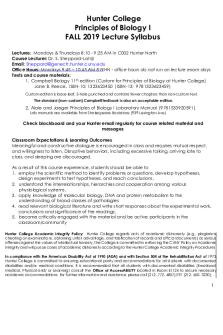BIOL100 Prelab 1 Hunter College Fall 2019 PDF

| Title | BIOL100 Prelab 1 Hunter College Fall 2019 |
|---|---|
| Author | Dibisha Roy Biswas |
| Course | Biology |
| Institution | Hunter College CUNY |
| Pages | 1 |
| File Size | 137.2 KB |
| File Type | |
| Total Downloads | 80 |
| Total Views | 147 |
Summary
Prelab for bio 100 relating to the beginning chapters of study...
Description
Name: Dibisha Roy
EMPLID: 23911332
Gradescope instructions: Please place answers into the answer area when applicable. Your response should not exceed the space provided. Do not submit a transcribed assignment (do not write this entire document over by hand). There are multiple ways that you can submit your assignment. Please check Gradescope.com for tutorials.
1. What determines the property of a polypeptide? Polypeptides are composed of amino acids where each amino acid consists of a central carbon bound to an amino group on one side and a carboxyl group on another. The central carbon is bound to a hydrogen atom and an unique sude chain or R group that makes each of the twenty amino acids found in polypeptide differ from one another which further determine the properties of a polypeptide.
2. Indicate your substrate for the Enzymes I experiment. What will the enzyme do to the substrate? The substrate in the Enzymes 1 experiment is para-nitrophenyl phosphate which consists of a six carbon ring (benzane) with one end of the ring covalently bonded with a phosphate while the other end of the ring is covalently bonded with a nitrate group. The addition of the enzyme, acid phosphate, will allow a water molecule to be introduced between the phosphorus atom and the oxygen atom that links the phosphate group to the benzene ring, and it will break the covalent bond. In simple word it would speed up the reaction so that we can measure product formation during the lab period.
3. How do you determine the micromoles of product seen at the end of your reaction? To determine the micromoles of product seen at the end of the reaction, we have to find the standard curve, using a spectrophotometer. We first have to find the measured absorbance for the sample on the y-axis, then use a straigh edge to trace the value horizontally to where it intersects the line for the standard curve, then place the straight edge at right angles to that point, and finally trace down to the point where it intersects the x-axis.
4. What is the specific difference between E tubes and C tubes? The specific difference between the E tubes and C tubes are that the E tubes will receive samples from the "experimental" part, while the C tubes receive samples from the "control" part of te time course, so they don't receive an enzyme to react with.
5. What purpose does the citrate buffer serve? The purpose of the citrate buffer is to allow the enzyme to go through a conformational change, which puts stress on existing bonds within the substrate that must be broken down while fostering new bonds that have to be made in order for a substrate to be converted into product, and to get more product. It also prevents the enzyme from changing before the end of the reaction since the enzyme being used int he experiment is acid phosphatase. Overall, citrate buffer also has alkanizing properties which make it not as susceptible to pH change with the additio of the substrate which is crucual to the experiment.
Pre-lab assignment #3 – Enzymes I...
Similar Free PDFs

Media 1 midterm - fall 2019
- 4 Pages

Syllabus Hunter Chem 104 Fall 18
- 6 Pages

BIOL100 Syllabus FA19 AUG1819
- 6 Pages

BIOL100 Syllabus SP19
- 6 Pages

Psych 140MSyllabus 2019 Fall
- 5 Pages

Syllabus 1X03 Fall 2019
- 19 Pages

Syllabus FIN351 Fall 2019
- 13 Pages

Syllabus Lifesciences Fall 2019
- 10 Pages

Prelab 9
- 3 Pages

MAN3025 Syllabus 2019 Fall
- 15 Pages

Math117Syllabus Fall 2019
- 2 Pages
Popular Institutions
- Tinajero National High School - Annex
- Politeknik Caltex Riau
- Yokohama City University
- SGT University
- University of Al-Qadisiyah
- Divine Word College of Vigan
- Techniek College Rotterdam
- Universidade de Santiago
- Universiti Teknologi MARA Cawangan Johor Kampus Pasir Gudang
- Poltekkes Kemenkes Yogyakarta
- Baguio City National High School
- Colegio san marcos
- preparatoria uno
- Centro de Bachillerato Tecnológico Industrial y de Servicios No. 107
- Dalian Maritime University
- Quang Trung Secondary School
- Colegio Tecnológico en Informática
- Corporación Regional de Educación Superior
- Grupo CEDVA
- Dar Al Uloom University
- Centro de Estudios Preuniversitarios de la Universidad Nacional de Ingeniería
- 上智大学
- Aakash International School, Nuna Majara
- San Felipe Neri Catholic School
- Kang Chiao International School - New Taipei City
- Misamis Occidental National High School
- Institución Educativa Escuela Normal Juan Ladrilleros
- Kolehiyo ng Pantukan
- Batanes State College
- Instituto Continental
- Sekolah Menengah Kejuruan Kesehatan Kaltara (Tarakan)
- Colegio de La Inmaculada Concepcion - Cebu




